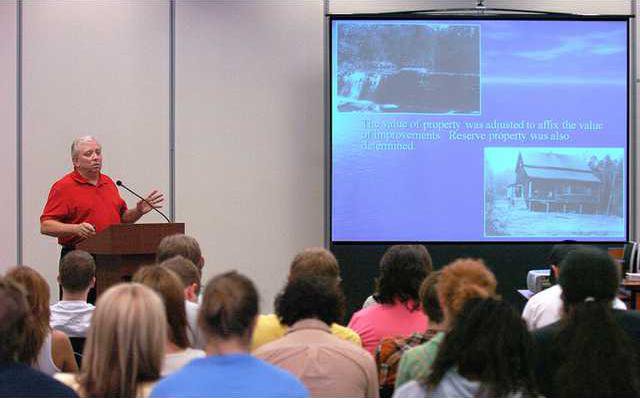OAKWOOD - Working at the U.S. Army Corps of Engineers in the summer of 1981, Robert David Coughlin took turns with other park rangers keeping watch at the dispatch desk.
During those stints, he would flip through old photographs and newspaper articles related to Lake Lanier's birth.
"I started trying to dig and get information, and that was a problem," Coughlin said. "There was no single body of work. It was fragmented and splattered all over the place."
Lake Lanier's history has since became his lifetime pursuit, one that culminated with writing a book, "Lake Sidney Lanier, A Storybook Site."
Coughlin also has spoken to groups, like the large student audience he faced at Gainesville State College Thursday morning. He was speaking as part of an Honors Colloquium sponsored by the college's Honors Program and foundation.
"Why did I write this book? Research is just something I enjoy doing - that and preserving the past," he told the group, packed into the Student Center's Robinson Ballroom.
Coughlin, a Gwinnett County educator, said he came across park rangers and other workers who took part in the building of Buford Dam.
He used the information he learned that first summer to create a slide show to share with his Georgia history students.
Coughlin, who lives in Buford, shared many pictures with Thursday's audience as part of a computerized presentation.
Photos depicted homes and businesses later swallowed up by the filling of Lake Lanier.
He also showed a picture of the Hosch Building off the downtown Gainesville square, where the corps handled the mapping, appraisals and negotiations for land going toward the project.
Some 700 families were displaced by the project, which began with a groundbreaking ceremony for Buford Dam in 1950 and a dedication ceremony in 1957.
The lake reached full pool of 1,070 feet above sea level at 1 p.m. on May 25, 1959, Coughlin said, adding that the full pool was increased by 1 foot in the 1970s.
He said Lanier was built for several reasons, including as a water source, which has become a contentious issue between Georgia, Alabama and Florida over the years. The issue still simmers in the federal courts, with the latest ruling, handed down in July 2009, favoring Alabama and Florida.
Back in its formation, Lake Lanier didn't stir much controversy.
Most early newspaper stories focused on "river consumption, water being pulled from the (Chattahoochee) river, not necessarily water from the reservoir itself," Coughlin said. "All that is contemporary."

